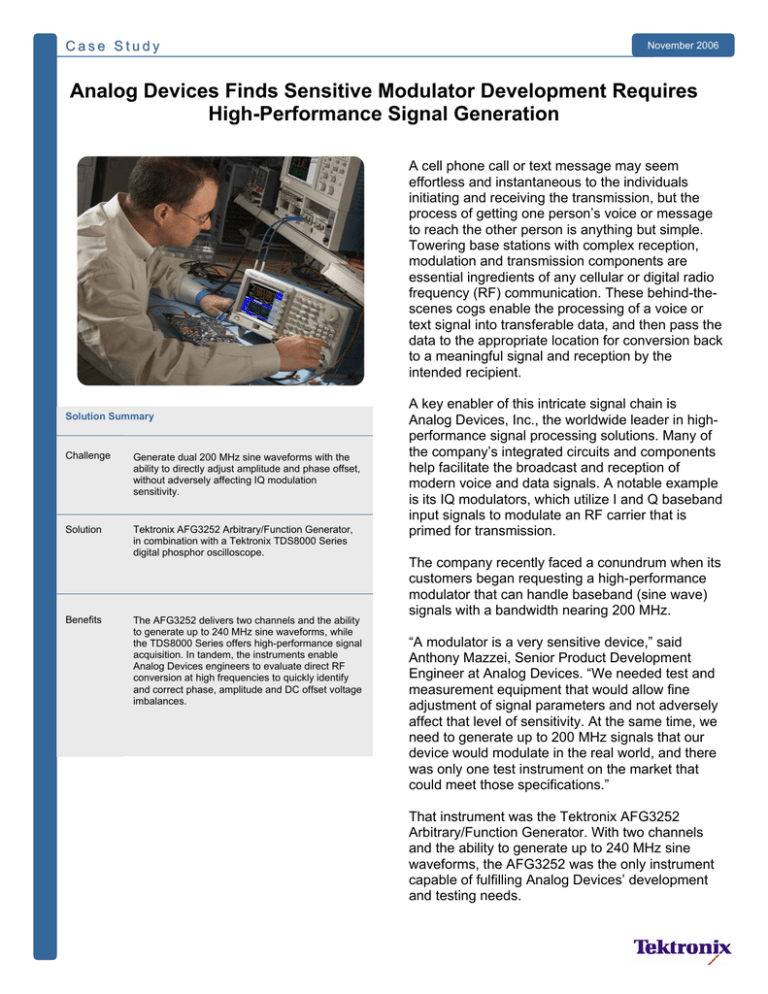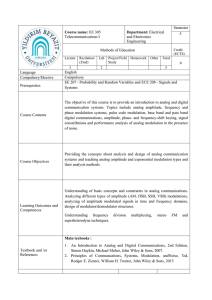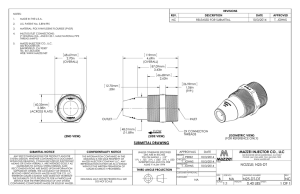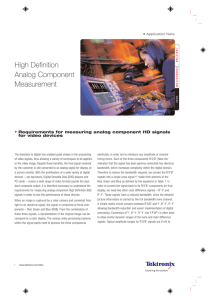
Case Study
November 2006
Analog Devices Finds Sensitive Modulator Development Requires
High-Performance Signal Generation
A cell phone call or text message may seem
effortless and instantaneous to the individuals
initiating and receiving the transmission, but the
process of getting one person’s voice or message
to reach the other person is anything but simple.
Towering base stations with complex reception,
modulation and transmission components are
essential ingredients of any cellular or digital radio
frequency (RF) communication. These behind-thescenes cogs enable the processing of a voice or
text signal into transferable data, and then pass the
data to the appropriate location for conversion back
to a meaningful signal and reception by the
intended recipient.
Solution Summary
Challenge
Generate dual 200 MHz sine waveforms with the
ability to directly adjust amplitude and phase offset,
without adversely affecting IQ modulation
sensitivity.
Solution
Tektronix AFG3252 Arbitrary/Function Generator,
in combination with a Tektronix TDS8000 Series
digital phosphor oscilloscope.
Benefits
The AFG3252 delivers two channels and the ability
to generate up to 240 MHz sine waveforms, while
the TDS8000 Series offers high-performance signal
acquisition. In tandem, the instruments enable
Analog Devices engineers to evaluate direct RF
conversion at high frequencies to quickly identify
and correct phase, amplitude and DC offset voltage
imbalances.
A key enabler of this intricate signal chain is
Analog Devices, Inc., the worldwide leader in highperformance signal processing solutions. Many of
the company’s integrated circuits and components
help facilitate the broadcast and reception of
modern voice and data signals. A notable example
is its IQ modulators, which utilize I and Q baseband
input signals to modulate an RF carrier that is
primed for transmission.
The company recently faced a conundrum when its
customers began requesting a high-performance
modulator that can handle baseband (sine wave)
signals with a bandwidth nearing 200 MHz.
“A modulator is a very sensitive device,” said
Anthony Mazzei, Senior Product Development
Engineer at Analog Devices. “We needed test and
measurement equipment that would allow fine
adjustment of signal parameters and not adversely
affect that level of sensitivity. At the same time, we
need to generate up to 200 MHz signals that our
device would modulate in the real world, and there
was only one test instrument on the market that
could meet those specifications.”
That instrument was the Tektronix AFG3252
Arbitrary/Function Generator. With two channels
and the ability to generate up to 240 MHz sine
waveforms, the AFG3252 was the only instrument
capable of fulfilling Analog Devices’ development
and testing needs.
“Other IQ signal generators on the market
can only muster a bandwidth of 20 to 40
MHz, which doesn’t come close to meeting
our requirements. The AFG3252, with the
capacity to produce two synchronous 240
MHz sine waves as well as fine amplitude
and phase control, quickly became a
design and test necessity.”
-Anthony Mazzei, Senior Product Development
Engineer, Analog Devices
From Research and Development Supplement
to Design and Test Necessity
According to Mazzei, Analog Devices initially
acquired and utilized the AFG3252 for
supplementary research and development
purposes.
“It’s a very affordable instrument, and at first we
used it to experiment with different operating
scenarios and conditions,” he recalled. “For
example, we were using the AFG3252 to see what
would happen if we put two continuous signals on
the same baseband. We were also using it to test
the limits of a signal chain by manipulating the local
oscillator interface with a square wave.”
Yet when Analog Devices’ customers started
calling for an IQ modulator with more than 100
MHz bandwidth, the AFG3252 took on a much
larger role. “Other IQ signal generators on the
market can only muster a bandwidth of 20 to 40
MHz, which doesn’t come close to meeting our
requirements.” Mazzei said. “The AFG3252, with
the capacity to produce two synchronous 240 MHz
sine waves as well as fine amplitude and phase
control, quickly became a design and test
necessity.”
Meeting frequency specifications was only half the
challenge, he explained. To assure high signal
quality, the I and Q arms of the modulator must be
symmetrical with respect to signal gain and phase
shift. Without this exactness, performance
degradation in the RF spectrum can follow,
resulting in spectral impurity and the carrier tone
bleeding into the output signal.
amplitude and phase between I and Q signals with
fine resolution.
“We need to produce the desired tone, suppress all
other harmonics and adjust sine and cosine
channels to accurately measure the modulator's IQ
imbalance and quadrature,” Mazzei noted. “It’s
certainly no small feat, but the AFG3252 delivers.”
He added that the performance and stability of the
instrument allow Analog Devices engineers to
evaluate IQ modulation at a higher frequency than
ever before, and to determine and correct phase,
amplitude and DC offset voltage imbalances with
greater speed and accuracy.
In conjunction with the AFG3252, Analog Devices
is utilizing a Tektronix TDS8000 Series digital
phosphor oscilloscope to measure and verify the
output signals of its latest IQ modulators. Mazzei
indicated this combination of high-performance
signal generator and oscilloscope delivers real
world data to characterize and validate the
performance of its device. In the past, he
explained, Analog Devices had to use – and was
subsequently constrained by – simulation data as
the only measure to describe its high-end
modulators’ performance.
“We have always been confident about the
capabilities of our modulators, but our customers
had to rely on and trust simulation data,” said
Mazzei. “We now have bona fide specifications to
show the real world capabilities of our new
modulation devices.”
With accurate data that proves Analog Devices’
latest IQ modulators are meeting customer
demands of 200 MHz performance, the product is
selling well and boosting the company’s bottom
line. Mazzei claimed his company’s favorite signal
generation instrument has also reduced
development and equipment costs.
“Not only has the AFG3252 met our performance
requirements and expedited our time to market, but
it’s also roughly 25 thousand dollars less expensive
than the lower frequency instruments we
considered,” he said. “The disparity doesn’t make
sense, but we’re not complaining.”
Therefore, the equipment used to evaluate and
characterize IQ modulation during the design stage
must also allow the user to directly adjust
Copyright © 2006, Tektronix, Inc. All rights reserved. Tektronix products are covered by U.S. and foreign patents, issued and pending. TEKTRONIX and TEK are registered trademarks of Tektronix,
Inc. All other trade names referenced are the service marks, trademarks or registered trademarks of their respective companies. 12/06 JS/WOW
75W-20319-0





